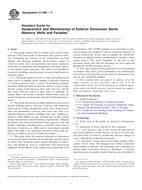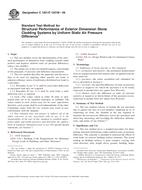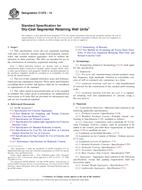We need your consent to use the individual data so that you can see information about your interests, among other things. Click "OK" to give your consent.
ASTM C1496-11
Standard Guide for Assessment and Maintenance of Exterior Dimension Stone Masonry Walls and Facades
STANDARD published on 1.10.2011
The information about the standard:
Designation standards: ASTM C1496-11
Note: WITHDRAWN
Publication date standards: 1.10.2011
SKU: NS-11543
The number of pages: 7
Approximate weight : 21 g (0.05 lbs)
Country: American technical standard
Category: Technical standards ASTM
The category - similar standards:
Annotation of standard text ASTM C1496-11 :
Keywords:
assessment, dimension stone, exterior cladding, façade, maintenance, natural stone, Assessment/Assesors--buildings, Building facades, Dimension stone, Exterior building stone, Maintenance, ICS Number Code 91.060.10 (Walls. Partitions. Facades)
Additional information
| Significance and Use | ||||||
|
This guide attempts to provide information to assist building owners and managers with limited knowledge of stone construction to recognize basic problems with performance of facades, and to keep them in good condition through periodic inspections and maintenance. Increased awareness of the behavior of stone masonry facades and associated materials can reduce maintenance and replacement costs by addressing problems and deterioration early. The objective of all maintenance should be to limit deterioration through early intervention. When it appears damage to stone support elements has occurred, professionals should be consulted to evaluate the support conditions, as well as recommend methods to restore the building's integrity and preserve public safety. |
||||||
| 1. Scope | ||||||
|
1.1 This guide outlines how to visually assess exterior stone masonry walls and facades to determine their general condition. Examining key features of the construction can help identify and diagnose problems which require repairs or corrective action. Such an examination can expose conditions which may be addressed with maintenance and minor repairs, or may require expert assistance. This guide is not intended to be used for buildings requiring major exterior rehabilitation or structural repairs. 1.1.1 This guide applies to walls of solid stone or dimension stone used as a cladding. Stone cladding is typically connected to a backup material with a variety of anchoring methods, including traditional hand-set masonry anchors such as straps, dowels, cramps, hook-and-eyes, dove-tails, wire ties, and the like. Joints between stones in these types of buildings are usually filled with mortar or sealant. Sealant-filled joints are usually designed to accommodate structural and thermal movements. 1.2 This guide specifically excludes dimension stone used in interior building surfaces, flooring or paving, slate dimension stone used as roofing. Though they share some similar assessment and maintenance concerns, thin stone (less than 2 in. nominal thickness) exterior cladding, and stone cladding attached to metal flames are also excluded due to their unique design characteristics and performance requirements. Although procedures and cautions listed herein may apply to walls and facades containing semi-dimension, or partially sized, stone in the form of split-face, or rubble and to stone-facade concrete panels, the guide is not specifically directed to such stone use. It does not address removal of small-area stains. 1.3 This guide offers an organized collection of information or a series of options and does not recommend a specific course of action. This document cannot replace education or experience and should be used in conjunction with professional judgment. Not all aspects of this guide may be applicable in all circumstances. This ASTM standard is not intended to represent or replace the standard of care by which the adequacy of a given professional service must be judged, nor should this document be applied without consideration of a project’s many unique aspects. The word “Standard” in the title of this document means only that the document has been approved through the ASTM consensus process. 1.4 The values stated in inch-pound units are to be regarded as standard. The values given in parentheses are mathematical conversions to SI units that are provided for information only and are not considered standard. 1.5 This standard does not purport to address all of the safety concerns, if any, associated with its use. It is the responsibility of the user of this standard to establish appropriate safety and health practices and determine the applicability of regulatory limitations prior to use. |
||||||
| 2. Referenced Documents | ||||||
|
Similar standards:
Historical
1.4.2009
Historical
15.11.2013
Historical
1.12.2011
Historical
1.7.2014
Historical
1.6.2013
Historical
1.2.2014
We recommend:
Technical standards updating
Do you want to make sure you use only the valid technical standards?
We can offer you a solution which will provide you a monthly overview concerning the updating of standards which you use.
Would you like to know more? Look at this page.



 ASTM C1201/C1201M-09..
ASTM C1201/C1201M-09.. ASTM C1280-13a
ASTM C1280-13a ASTM C1355/C1355M-96..
ASTM C1355/C1355M-96.. ASTM C1372-14
ASTM C1372-14 ASTM C1381/C1381M-97..
ASTM C1381/C1381M-97.. ASTM C1396/C1396M-14..
ASTM C1396/C1396M-14..
 Cookies
Cookies
